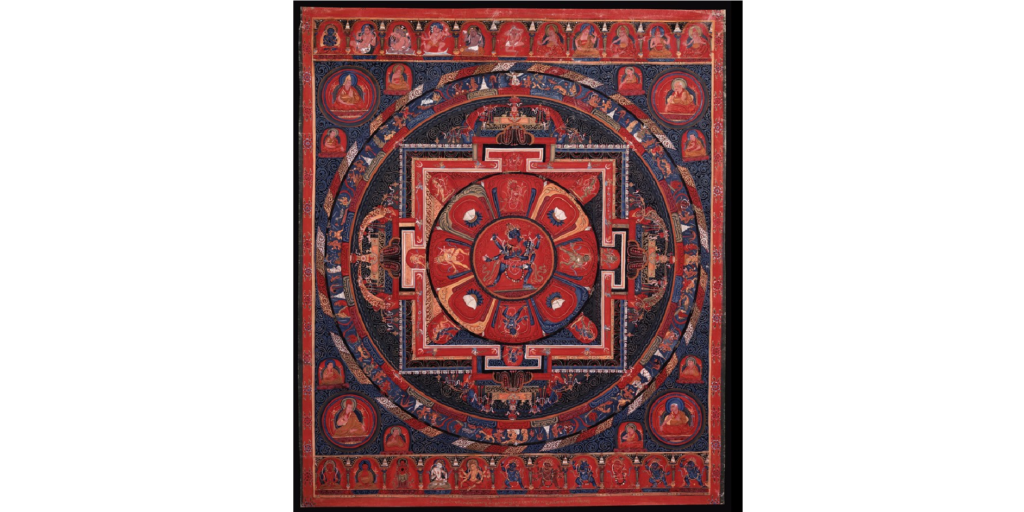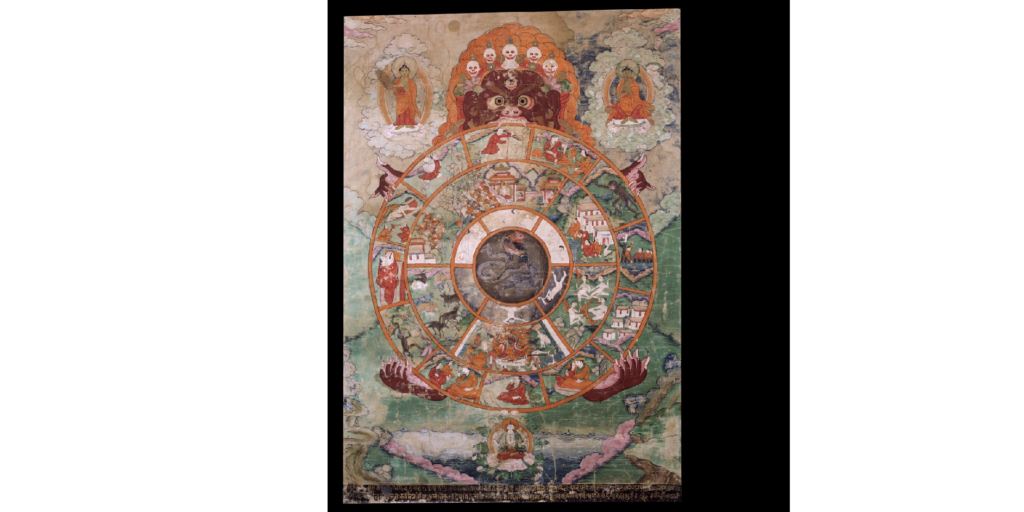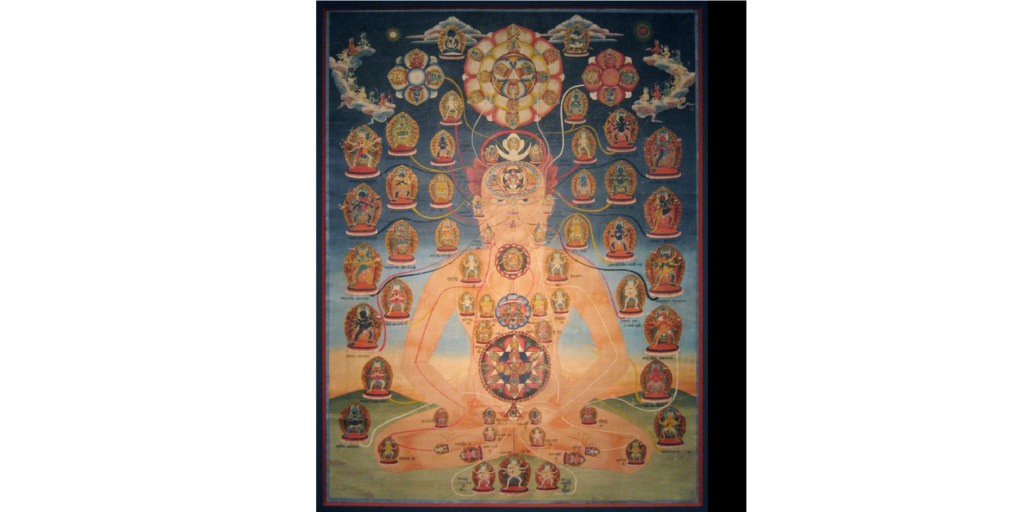Growing up in Bhutan, Buddhist art and religious paintings were an integral part of my daily life. They were everywhere, from the walls of our homes to the monasteries and temples we visited. As a child, I was fascinated by the intricate details and vivid colors of these paintings, but I never really thought about their deeper meaning or cultural significance. As I grew older, they became even more familiar to me, and I never really questioned their relevance. However, now, as I am taking this Intro to Asian art course, which talks extensively about Buddhist art, I am starting to view these paintings in a new light. I am learning about their history, symbolism, and cultural significance, and I am beginning to see them as more than just familiar objects from my childhood. This process of rediscovery has been fascinating, and I am excited to learn more about the rich history and meaning behind these beautiful artworks. Recently, in the past two years, I have been interested in the practice of meditation and the use of it to achieve enlightenment. Learning about concepts such as samadhi, vipassana and many others I’ve learnt that the exploration of the human mind in Buddhism is very vast and profound. And as we learned the various forms of Buddhist art, I found myself particularly captivated by the Mandala. The Mandala’s symmetric beauty was mesmerizing, but what truly drew me in was its connection to meditation and spiritual enlightenment. How does this painting help in the process of meditation? Which forms or phases of meditation is this art form used in? And what particular concept is this art piece meant to convey?
As I pondered on the above questions, I knew that this had to be my final project. To explore in depth the link between enlightenment and mandalas and hopefully become enlightened while learning about it.
To explore this idea I chose 5 art pieces that I thought represented the diversity of practices in Buddhism and also highlighted the use of mandalas for enlightenment. The first art piece that I chose was the mandala of Chakrasamvara(fig 1). One of the most famous mandalas and is one of the quintessential types of mandala. The second art piece that I chose is a Chenrezig Sand Mandala(fig 2). I chose this piece because the concept of impermanence and emptiness is heavily tied into the creation of this art piece. The third art piece I chose is Sidpai Khorlo(fig 3), a mandala representing the six realms of life. This piece is concerned with the esoteric parts of Vajrayana Buddhism and I wanted to explore this art piece since it presented a different part from the usual “secular” representation of buddhism in media. The fourth and fifth art pieces I chose were a body mandala that originated from Nepal(fig 4) and the body mandala of Chakrasamvara(fig 5). I chose these two pieces since Buddhism and meditation have a lot of secret practices often called Tumho and body mandalas are explicitly used to convey these secret teachings or to highlight the important aspects of the body from a Buddhist perspective. I felt that through these 5 paintings I could explore mandalas and the use of it in Buddhism from different dimensions.
What is common throughout the 5 mandalas is their inherent symmetry in each of the representations. Each of the figures or art pieces are always centered at either the middle of the circle or the core of the body. As can be seen in the mandala of Chakrasamvara the central point of the mandala is Chakrasamvara whereas in the mandala of Chenrezig we have a lotus, a common pedestal for divine figures, as the central point. Another point to note in the sand mandalas and Chakrasamvara mandalas is the attention to detail, the complexity of any point in the mandala yet the simplicity of its foundations. Mandala in sanskrit translates to “circle”, and I think this also shows how the mandala is an amalgamation of complexity and simplicity. Where essentially it is a mix of squares and circles. Figures 1 and 2 also feature multi-colored flames on the borders of the largest circle which is meant to reflect the multi-colored flames of pristine awareness.
Even in Figure 3, which is the wheel of life, the eyes are drawn towards the center of the circle. In Figures 1-3 we can also notice a pattern of filling in the space. Where the empty parts between the different shapes are filled either with figures or with different objects that are relevant in Buddhism. In figure 3 the spaces within the circle represent different realms and different stages of life. In figure 4 and 5 we can see the importance given to the abdomen of the human body. Where in figure 4 it is the central point of the diagram and can be considered the axis-mundi, and in figure 5 we have a huge almost a mini mandala in itself centered on the abdomen. Body mandalas also feature a human figure which is overlaid with bodhisattvas in figure 5 and overlaid with different shapes in figure 4. And the shapes are strategically placed over certain parts of the body.
Sand mandalas are usually drawn at ground level on a simple platform although figure 2 is on a pedestal, and I think that this is very similar to Rangolis in hinduism. Where beautiful and strenuous art is drawn on the ground and it makes people aware of the steps that they take so as to be careful not to step on the art. And I think this process of becoming aware of the feet is heavily done by the placement of the art on the ground.
Although the source of figure 3 does not mention where the art is displayed, Sidpai Khorlo is usually drawn on the walls of temples. It is a sacred piece of art and is drawn very largely relative to the pictures of bodhisattvas. This largeness attracts the attention of the visitors and serves as a reminder of the impermanence. Because this is only displayed at a temple and not in regular altars, the significance of it increases since temples are sacred and are visited for a purpose. Because most of the mandalas that are similar to figures 1-3 are drawn in temples, the atmosphere and sacredness of these sites contribute to the perception of the mandala as a holy object, and the architectural context shapes the experience of viewing and interacting with it. The intricate details, vibrant colors, and intricate patterns of the mandalas are enhanced and amplified when viewed within the context of a temple, creating a sense of harmony and spiritual connection between the individual and the divine. This context therefore plays an important role in shaping the meaning and experience of the mandala, rendering it much more than just a mere decorative art form.
Body mandalas are known to be rare and aren’t as widely produced as the typical mandalas. As such I couldn’t find much information on the architectural context of these mandalas.
The circle in mandalas represents the cosmos while the square represents the symbol of the earth or the man made world.
The idea of macrocosms and microcosms can help us understand the concept of the mandala as the cosmic center. Samye Monastery’s layout is modeled after a mandala, with the central temple serving as the mandala’s focal point and the outlying structures and courtyards reflecting the negative space in mandalas(Fisher, pg 137).
The monastery also has a number of smaller temples and chapels, which resembles the mandala-like arrangement of different deities. The complex mandalas that adorn the walls of these buildings as well as the general design of the monastery’s buildings serve as almost a fractal design of the world. This representation of the mandala is inline with the thought of how each human being is a mandala unto himself(Argüelles, pg 19).
In the mandala of Chakrasamvara, the central figure shows Chakrasamvara embracing Vajravarahi. The sexual imagery represents the symbols of the countless pairs of opposites. The male and the female are similar to the yin and yang. The concentric circle in the mandalas almost looks like the structure of the eye. The books of ancient seers of India are called Vedas, a Sanskrit word for vision and wisdom(Argüelles, pg 23). The heavy importance of the concentric circles almost remind the viewers to see the direct perception of reality through the superficial nature of things. This might be related to the concept of Tongpanyi or emptiness. Mahayana and vajrayana imply that all things exist as a result of independence and causality and nothing exists on its own. And seeing this emptiness is a central tenet of Mahayana Buddhism(Karma, pg 1).
In vajrayana buddhism the relationship between the guru and the student is the most important facet. Whereby the student is expected to fully trust the teachings of the guru. Mandalas were often used by gurus to instruct students how to “see”. The pilgrimage most often included starting from the outer flame rings and then slowly moving in towards the palace of the deity(Walcott, pg 77). The sand mandalas are consecrated on the ground to represent the seat of Buddha’s enlightenment and is considered a sacred precinct at the base of a bodhi tree(Walcott, pg 78).
Mahayana Buddhism puts a heavy emphasis on knowing one’s body and using it as a medium for transcendence(Dachille, page 58). This concept is highlighted by the fact that Mahayana Buddhism developed its own sophisticated understanding of the body’s hidden sites of power and movement of energies through these sites in the form of lung or chi/chakra. And so we see the role of mapping mandalas onto human form and the recursive concept of microcosms and macrocosms. Body mandalas such as the ones in figure 4 and 5 were used mainly for dissemination of teaching and not for worship purposes.
Vajrayana yogic practices are known to be secretive and are not passed on to the uninitiated in Tibet and so it is interesting to see how the body mandala in figure 4 originated from nepal. These body mandalas which have deities drawn on to a human figure might be considered a way of punctuating the sites of particular strength or vulnerability(Dachille, page 210).
The commonality among these mandalas, excluding Sidpai Khorlo, is the heavy focus on the macrocosm and microcosm, the idea of perceiving the universe within the human body. This concept is achieved in different ways, but the underlying theme is rooted in Buddhism and a mixture of philosophies from Hinduism. Most body art or lung art forms were derived from Ayurvedic practices, highlighting the essence of Asian Art. Religion plays a significant role as a distributor and sponsor of these art forms. Buddhism, in particular, heavily influences Asian art, with its blend of Hindu-inspired motives. Many artworks serve as aids to meditation, act as devotional objects, or represent deities and other important figures. Asian art, in my opinion, is deeply intertwined with religion and spirituality.
Images

Size: 21 x 18 inch
Material: Cloth
Date: ~16th century
Origin: Ewam Monastery, Tibet
Source: Rubin Art Museum
Himalayan art resources #: 65020URL: https://collection.rubinmuseum.org/objects/690/mandala-of-chakrasamvara-and-vajravarahi

Date: 2008
Origin: Tibet
Location: House of Commons (UK)
Material: Sand
URL: https://upload.wikimedia.org/wikipedia/commons/thumb/d/da/Chenrezig_Sand_Mandala.jpg/800px-Chenrezig_Sand_Mandala.jpg?20110907115243

Origin: Eastern Tibet
Date: ~18th Century
Source: Himalayan art
Size: 60*42 cm
Material: Mineral pigment on cotton cloth
URL: https://www.himalayanart.org/items/591

Origin: Nepal
Date: ~20th century
Source: Himalayan art
URL: https://www.himalayanart.org/items/12462

Origin: Nepal
Date: ~19th century
Source: Himalayan Art
Material: Mineral pigment on cotton cloth
URL: https://www.himalayanart.org/items/59648
Bibliography
[1] Argüelles, José, and Miriam Argüelles. Mandala. Boston: Shambhala, 1985.
[2] Phuntsho, Karma. “Tongnyi: Emptiness.” Texts. Accessed May 15, 2023. https://texts.mandala.library.virginia.edu/book_pubreader/51196#!po=25.0000.
[3] Walcott, Susan M. “Mapping from a Different Direction: Mandala as Sacred Spatial Visualization.” Journal of Cultural Geography, 2006, 71–88.
[4] Dachille, R. “The Body Mandala Debate: Knowing the Body through a Network of Fifteenth-Century Tibetan Buddhist Texts”. UC Berkeley. ProQuest ID: Dachille_berkeley_0028E_15839. Merritt ID: ark:/13030/m5qc4rc7. Retrieved from https://escholarship.org/uc/item/2850d3rf, (2015)